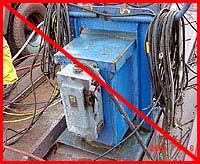Shipyard Employment eTool
General Working Conditions >> Utilities
Workers must be protected from hazards associated with the unchecked release of steam or electricity, excessive wear and tear of steam hoses that could compromise their integrity, and burns and fires from unguarded heat lamps (29 CFR 1915.83).
Potential Hazard
Worker injuries can be caused by the accidental release of steam or steam explosions.
Requirements and Example Solutions
- Vessel steam piping systems, including hoses, must be designed to safely handle the working pressure prior to supplying steam from an outside source (29 CFR 1915.83(a)(1)).
- A responsible vessel's representative, a contractor, or other qualified person (i.e., training, knowledge, or experience) must inspect each steam piping system, prior to use, to determine that the working pressure is safe (29 CFR 1915.83(a)(1)).
- Relief valves must be positioned to eliminate the possibility of inadvertently disconnecting them, or where the release of steam is likely to cause injury (29 CFR 1915.83(a)(2)(iii) and (v)).
- Steam hoses must be protected from damage, including the minimizing of chafing and reduction of tension through the use of short bights during hanging (29 CFR 1915.83(b)(2) and (b)(3)).
- Steam hoses or temporary steam piping systems, including metal fittings and couplings, must be shielded to protect workers from contact when located in walking or working areas (29 CFR 1915.83(b)(4)).

Potential Hazard
Worker injuries may include electrical shock and burns from electric power supplied to the vessel.

Requirements and Example Solutions
- Before the connection or energization of electric shore power, the vessel must be grounded and each circuit be energized with over-current protection that does not exceed the rated current-carrying capacity of the conductors (29 CFR 1915.83(c)(1) and (c)(2))
- A responsible vessel's representative, a contractor, or other qualified person (i.e., training, knowledge, or experience) must inspect each circuit to be energized to determine that it is in a safe condition before electric shore power is energized (29 CFR 1915.83(c)(3)).
Potential Hazard
Worker injuries can be caused by inadvertent contact with heat lamp bulbs and other hot parts.
Requirements and Example Solution
- Heat lamps, including their face, must be equipped with surround-type guards to prevent contact with the lamp and bulb (29 CFR 1915.83(d)).

